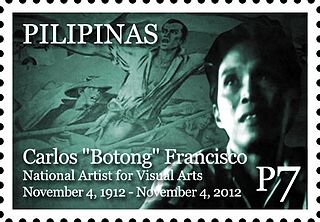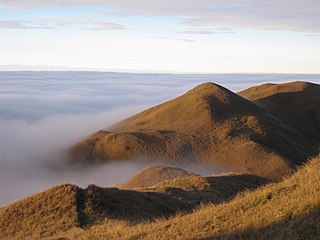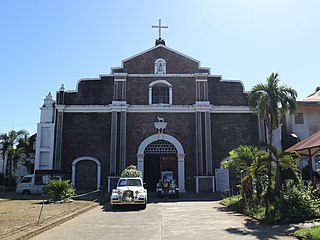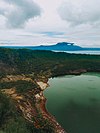
Rizal, officially the Province of Rizal, is a province in the Philippines located in the Calabarzon region in Luzon. Its capital is the city of Antipolo. It is about 16 kilometers (9.9 mi) east of Manila. The province is named after José Rizal, one of the main national heroes of the Philippines. It is bordered by Metro Manila to the west, Bulacan to the north, Quezon to the east and Laguna to the southeast. The province also lies on the northern shores of Laguna de Bay, the largest lake in the country. Rizal is a mountainous province perched on the western slopes of the southern portion of the Sierra Madre mountain range.

A petroglyph is an image created by removing part of a rock surface by incising, picking, carving, or abrading, as a form of rock art. Outside North America, scholars often use terms such as "carving", "engraving", or other descriptions of the technique to refer to such images. Petroglyphs, estimated to be 20,000 years old are classified as protected monuments and have been added to the tentative list of UNESCO's World Heritage Sites. Petroglyphs are found worldwide, and are often associated with prehistoric peoples. The word comes from the Greek prefix petro-, from πέτρα petra meaning "stone", and γλύφω glýphō meaning "carve", and was originally coined in French as pétroglyphe.

In archaeology, rock art is human-made markings placed on natural surfaces, typically vertical stone surfaces. A high proportion of surviving historic and prehistoric rock art is found in caves or partly enclosed rock shelters; this type also may be called cave art or parietal art. A global phenomenon, rock art is found in many culturally diverse regions of the world. It has been produced in many contexts throughout human history. In terms of technique, the four main groups are:

Taytay, officially the Municipality of Taytay, is a 1st class urban municipality in the province of Rizal, Philippines. It is also known as the Garments Capital of the Philippines. Most occupation of the residents are related to supplying different types of garments related things like blouses, pants, dresses and the garment itself at a very low cost.

Angono, officially the Municipality of Angono, is a 1st class urban municipality in the province of Rizal, Philippines. According to the 2020 census, it has a population of 130,494 people.

Binangonan, officially the Municipality of Binangonan, is a 1st class urban municipality in the province of Rizal, Philippines. According to the 2020 census, it has a population of 313,631 people.

Bontoc, officially the Municipality of Bontoc, is a 2nd class municipality and capital of the province of Mountain Province, Philippines. According to the 2020 census, it has a population of 24,104 people.

Carlos Modesto "Botong" Villaluz Francisco was a Filipino muralist from Angono, Rizal.

Destiny Cable was a direct-to-home cable television subscription service based in Quezon City. Destiny Cable was the 2nd largest cable TV provider in the Philippines. It was owned by Sky Cable Corporation.
The Arts in the Philippines are all the arts in the Philippines, from the beginning of civilization to the present. They reflect a range of artistic influences on the country's culture, including indigenous art. Philippine art consists of two branches: traditional and non-traditional art. Each branch is divided into categories and subcategories.

Indigenous Philippine shrines and sacred grounds are places regarded as holy within the indigenous Philippine folk religions. These places usually serve as grounds for communication with the spirit world, especially to the deities and ancestral spirits. In some cases, they also function as safeguards for the caskets of ancestors, as well as statues or other objects depicting divine entities.

Morong was an administrative division of the Philippines that existed as a politico-military district created out of parts of the provinces of Tondo and Laguna on February 23, 1853, by a decree of the Superior Gobierno, composing Morong, Pililla, Tanay, Baras, Binangonan, Jalajala, Angono and Cardona from Laguna; and Antipolo, Boso-Boso, Cainta and Taytay from Tondo. The offices were housed at a building now known as Comandancia. Its first military governor was Francisco Turrentigue.

St. Andrew the Apostle Parish, commonly known as Bacarra Church is a Roman Catholic church located in the municipality of Bacarra, Ilocos Norte, Philippines under the jurisdiction of the Roman Catholic Diocese of Laoag.

Nemesio “Nemi” R. Miranda Jr., also known as Nemiranda, is a Filipino painter and sculptor in Angono, Rizal. He gained fame as the forerunner the art form “Imaginative Figurism”. He has a degree in Bachelor of Fine Arts from University of Santo Tomas, Manila, Philippines. He is the father of modern artist Keiye Miranda.
Katrina "Keiye" Miranda-Tuazon is a modern art painter from Angono, Rizal. Also known as "Keiye Miranda", daughter of the famous painter, Nemesio Miranda Jr. She was known for her underwater pool themed paintings. She had her first solo exhibition at Surrounded by Water in Angono, Rizal and also had a show in a gallery that her family is managing in SM Megamall at the Nemiranda Arthouse where she first started to do her underwater themed painting. She was inspired to continue her underwater-themed paintings after receiving positive feedback from her family and peers.

The archaeology of the Philippines is the study of past societies in the territory of the modern Republic of the Philippines, an island country in Southeast Asia, through material culture.

Rizal's 1st congressional district is one of the four congressional districts of the Philippines in the province of Rizal. It has been represented in the House of Representatives of the Philippines since 1916 and earlier in the Philippine Assembly from 1907 to 1916. The district consists of the western Rizal municipalities of Angono, Binangonan, Cainta and Taytay. It is presently the largest legislative district in the country in terms of population. It is currently represented in the 19th Congress by Michael John R. Duavit of the Nationalist People's Coalition (NPC).
Marra Wonga, formerly known as Gracevale, is a major Aboriginal rock art site near Barcaldine in Queensland, Australia. The location of a sandstone escarpment forming a rock shelter over 160 metres in length, it comprises 111 stencils and over 15,000 petroglyphs (carvings), the oldest of which date back more than 5,000 years. The petroglyphs are mostly lines, grooves, drilled holes, and representations of animal tracks, although a cluster of human feet with six toes is carved into the floor of the shelter. Amongst the unique compositions to be found at Marra Wonga are "engraved star-like designs with central engraved pits and large, engraved snake-like designs running across and through other petroglyphs".




















